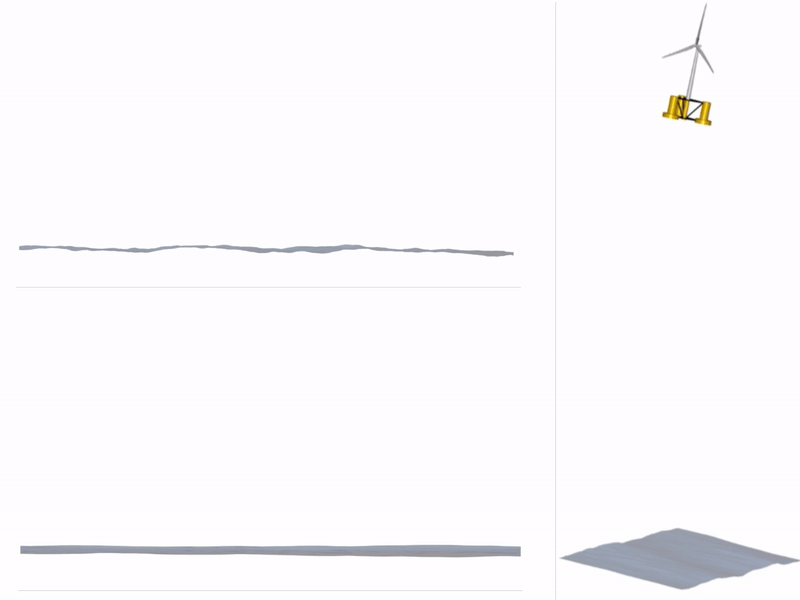Forum
Important Notice for New User Registrations
To combat an increasing number of spam and bot registrations, we now manually approve all new user registrations. While this may cause a delay until your account is approved, this step is essential to ensure the quality and security of this forum.
To help us verify your registration as legitimate, please use a clear name as user name or an official email address (such as a work, university, or similar address). If you’re concerned that we may not recognize your registration as non-spam, feel free to email us at with a request to approve your username.
VAWT Cp Not Converging in Turbulent Wind Simulation
Quote from abdmzhmmh on 18. June 2025, 00:07Hello everyone,
I’m running a simulation for an H-type VAWT in a turbulent wind field and I’m having trouble getting the Power Coefficient (C_p) to converge to a stable average value.
As you can see in the plot below, the C_p fluctuates significantly throughout the 40-second simulation. While some fluctuation is expected with turbulent wind, this seems excessive and doesn’t appear to be settling.
Simulation Setup
Here are the key details of my setup, with screenshots of the relevant settings panels attached below.
Turbine & Aerodynamics
- Type: H-Type VAWT
- Radius: 1 m
- Rotor Height: 1 m
- Blades: 3 x NACA 0015
- Dynamic Stall Model: Gormont-Berg
Simulation Control
- Rotational Speed: Fixed RPM of 214.859. This was set to achieve a target TSR of 3 based on the mean wind speed.
- Controller: None.
- Simulation Length: 40 s
- Timestep: 0.000775702515 s
Wind Field
- Standard: IEC 61400-2
- Mean Wind Speed (at hub height): 7.5 m/s
- Turbulence Class: A (High turbulence)
- Hub Height: 10.5 m
My Question
- Is this large fluctuation in C_p normal behavior for a fixed-RPM VAWT operating in high turbulence (Class A), or does it suggest a problem with my setup?
- The simulation seems to be tracking the turbulent wind speed, but I expected the averaged C_p to become more stable over time. Is 40 seconds too short for this type of analysis?
- Are there any specific parameters in the Turbine Definition (e.g., wake model settings) or Simulation Settings that you would recommend adjusting to achieve a more stable result or to diagnose if this is a numerical instability?
Any advice or insights would be greatly appreciated. Thank you!
Hello everyone,
I’m running a simulation for an H-type VAWT in a turbulent wind field and I’m having trouble getting the Power Coefficient (C_p) to converge to a stable average value.
As you can see in the plot below, the C_p fluctuates significantly throughout the 40-second simulation. While some fluctuation is expected with turbulent wind, this seems excessive and doesn’t appear to be settling.
Simulation Setup
Here are the key details of my setup, with screenshots of the relevant settings panels attached below.
Turbine & Aerodynamics
- Type: H-Type VAWT
- Radius: 1 m
- Rotor Height: 1 m
- Blades: 3 x NACA 0015
- Dynamic Stall Model: Gormont-Berg
Simulation Control
- Rotational Speed: Fixed RPM of 214.859. This was set to achieve a target TSR of 3 based on the mean wind speed.
- Controller: None.
- Simulation Length: 40 s
- Timestep: 0.000775702515 s
Wind Field
- Standard: IEC 61400-2
- Mean Wind Speed (at hub height): 7.5 m/s
- Turbulence Class: A (High turbulence)
- Hub Height: 10.5 m
My Question
- Is this large fluctuation in C_p normal behavior for a fixed-RPM VAWT operating in high turbulence (Class A), or does it suggest a problem with my setup?
- The simulation seems to be tracking the turbulent wind speed, but I expected the averaged C_p to become more stable over time. Is 40 seconds too short for this type of analysis?
- Are there any specific parameters in the Turbine Definition (e.g., wake model settings) or Simulation Settings that you would recommend adjusting to achieve a more stable result or to diagnose if this is a numerical instability?
Any advice or insights would be greatly appreciated. Thank you!
Uploaded files:- You need to login to have access to uploads.
Quote from David on 18. June 2025, 02:56Hi,
at first glance your results look reasonable.
The turbine is running at a constant rpm, and not following the changing windspeed (e.g. no power tracking). Thats why you are getting tip speed ratios between 2.5 and 4.5 – and the power coefficient Cp fluctuates. To have power tracking you would need to integrate a controller library – unfortunately, Off-the-shelf controllers for VAWTs are rare, so you would need to develop your own or use a simulation input file to prescribe the rotational speed manually.
Keep in mind that Cp is not a particularly robust metric in highly turbulent inflow, so I would recommend looking at absolute power or thrust.
The wake settings look ok, but you could increase the timestep to an azimuthal step of ~3 or slightly more for a much faster simulation.
Best regards,
David
Hi,
at first glance your results look reasonable.
The turbine is running at a constant rpm, and not following the changing windspeed (e.g. no power tracking). Thats why you are getting tip speed ratios between 2.5 and 4.5 – and the power coefficient Cp fluctuates. To have power tracking you would need to integrate a controller library – unfortunately, Off-the-shelf controllers for VAWTs are rare, so you would need to develop your own or use a simulation input file to prescribe the rotational speed manually.
Keep in mind that Cp is not a particularly robust metric in highly turbulent inflow, so I would recommend looking at absolute power or thrust.
The wake settings look ok, but you could increase the timestep to an azimuthal step of ~3 or slightly more for a much faster simulation.
Best regards,
David


